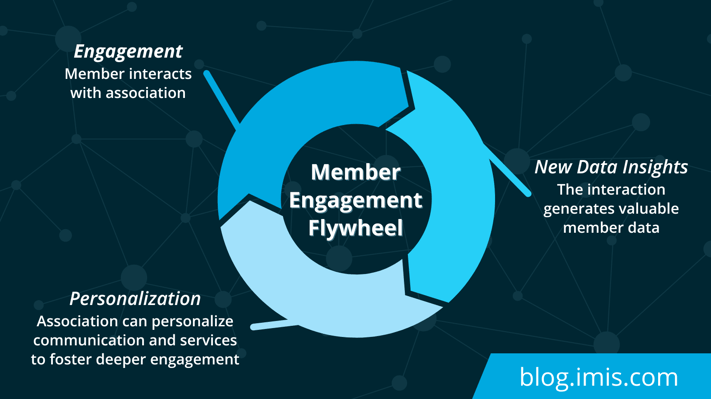8 Strategies for Union Member Recruitment
Acquire more union members with tactics like showcasing your success, identifying influencers, and gathering valuable data.
For membership organisations, associations, and unions, measuring digital engagement gives you a deeper understanding of your members.
Digital engagement is an industry buzzword you've likely heard. Put simply, digital engagement is interest, attention and interaction through digital channels. Channels typically include:
For membership organisations, associations, and unions, understanding and measuring digital engagement can help you have a deeper understanding of your members.
Specifically for membership-based organisations, engagement is driven by a purpose. It can be helpful to consider this as a member journey: the paths people take through your organisation when they interact with you.
For example, a member-led journey could be where someone starts from a low level of engagement and becomes a key stakeholder. You can look at the next actions you would like this person to take to decide the steps on their member journey.
The first step of building this journey is understanding who you want to engage with. A common way to do this is to create personas. Creating personas will help you work out what the member journey looks like from your ideal member’s perspective.

This process doesn’t have to be too granular to be successful. For example, one society has grouped their audience into four categories:
Once you have established your personas, you can then work out the journey someone is going to take with your organisation. It can be helpful to work this out in 3 steps:
Let’s say someone visits your website, they want information, they get the pages on your website to browse, and they give you their attention. For members, they want member services, they get your membership offering, and they may give you money for this. By building out the journey based on personas, you can work out the resources you need in place.
Marketing is often multi-channelled. So you’re likely to use a range of third-party apps or software to manage your activity. To be able to accurately measure digital engagement, it’s important to have all your data pulling into one location. This is also known as a Single Source of Truth (SSoT).
Go from data silos to a Single Source of Truth (SSoT). Learn more in the free guide from iMIS: It’s Not You, It’s Your Data Silos
By having data centralised, you can set up engagement scoring in your membership management system. When a member completes an action, your system gives them a score. You can define these scores based on what’s important for your organisation. For example, a higher score for an event registration compared to opening an email.
There are two common methods of engagement scoring:
This is an absolute approach, which assigns a score to a particular interaction. This method will add all the scores up for each member. The higher the score, the more engaged they are. The score is a sum total of all earned points.
A drawback of this method is that the sum is always going to be changing, so it can be difficult to create categories.
For example, at the beginning of the year, a high engagement score may be 70. But by the end of the year, after members have racked up more engagement points, 70 is only a middle score. So, you have to consistently keep an eye on the average number.
Here you have a weighting that's attributed to the different interactions that the individual is having with you. Then you condense those interactions into score out of 100. This can make it much easier to categorise your members.
For example, you know that any member with a score higher than 80% is highly engaged. While it's still worth it to track the average score, you can more quickly compare scores to each other since the 1-100 scale never changes.
Once you have engagement scoring in place, you can identify:
Then tailor your messaging and communications dependent on their needs.
Learn how to create an engagement scoring strategy that supports your goals. From the 3 Rs of Membership series.
If you want to have a better understanding of your members, you need to collect their data. Consider who you are collecting data from, what you will collect, and how you will collect it.
When you ask for data, this needs to be part of a value exchange. What does the contact get in return for their information? Typically, the more data you ask for, the higher the value of the exchange needs to be.
You can develop relationships with your members by collecting more data from them over time and understanding their behaviours. Whilst many people gather contact details, it can also be good to gather information on birthdays, occupations, salary, and interests.

Don’t forget about preferences! This allows your contact to choose how and when you communicate with them. This helps build trust and confirms the member’s interest.

Don’t overlook the power of personalisation across digital channels.
You want to send the right message, to the right people, at the right time, on the channel that's best for them. AI tools are helping make this process easier. For example, send-time optimisation allows you to send an email when it’s most likely to be opened by the contact.
You can use automated email campaigns to keep engaging your members, rather than sending mass emails.
Consider automated emails based on actions (or lack thereof), for example if a contact viewed your events page, or if a new member hasn’t logged into the portal yet.
%20Series/2%20-%20Unforgettable%20Web%20Experience/2024-iMIS_WP_unforgettable-web-experience_form-page-top-image-crop1.png?width=204&height=150&name=2024-iMIS_WP_unforgettable-web-experience_form-page-top-image-crop1.png) Helpful guide from iMIS: Delivering an Unforgettable Web Experience. This whitepaper highlights how delivering a highly personalised online environment draws people in and is a key element of your recruitment and retention strategy.
Helpful guide from iMIS: Delivering an Unforgettable Web Experience. This whitepaper highlights how delivering a highly personalised online environment draws people in and is a key element of your recruitment and retention strategy.
A missed opportunity for many membership organisations is a welcome journey. This is also called a member onboarding journey. You might send an email when someone joins. But consider sending a series of automated emails to help them get the most out of their new membership.
Make sure you demonstrate your member value proposition. After all, the effort to get members to renew doesn't start during renewals season.
Deliver a personalised and frictionless experience for your new members.
Get more ideas in the iMIS Blog article, Member Engagement: A Guide + 12 Strategies to Win Loyalty.
Only by measuring engagement can you see what needs to be improved. You can then put actions in place to provide tailored content and consider the needs of your members throughout their journey.
The insights in this article are key findings from the Zentso + Dotdigital webinar, "How to measure digital engagament." Watch the webinar recording.
iMIS® is an all-in-one membership management system that boosts engagement, operational efficiency, and program value for membership organizations like yours.
About Zentso: Zentso are membership CRM.
We help membership organisations, associations and unions to get strategic value from data and tech and to continuously evolve and be more successful.
If you’re stuck in a cycle of reactive support, spending too much time and money maintaining bespoke solutions that aren't future-proofed, Zentso has answers.
Our local, straight-talking specialists are always available to build and support your tech solutions and ensure your organisational progress.
We are implementation and development partners for iMIS. Our vast library of award-winning add-ons help you achieve your goals with clicks-not-code.
We care about our clients as much as they care about their members - Zentso, here when you need us.
Acquire more union members with tactics like showcasing your success, identifying influencers, and gathering valuable data.
Uncover key trends from the Membership Performance Benchmark Report and explore member retention strategies for your association, union, or...
Boost union membership with a website that showcases your value, personalizes content, and drives member engagement.